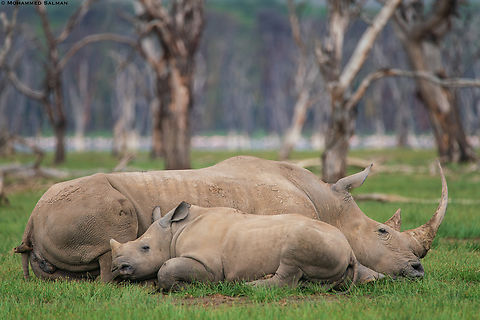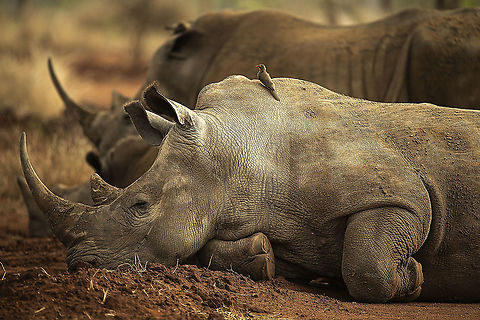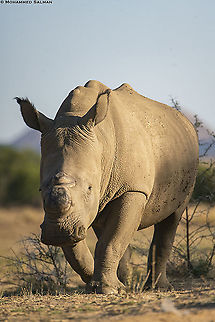
Appearance
The southern white rhinoceros is one of largest and heaviest land animals in the world. It has an immense body and large head, a short neck and broad chest. Females weigh 1,700 kg and males 2,300 kg. The head-and-body length is 3.4–4 m and a shoulder height of 160–186 cm . On its snout it has two horns. The front horn is larger than the other horn and averages 60 cm in length and can reach 150 cm . Females usually have longer but thinner horns than the males which is larger but shorter. The southern white rhinoceros also has a prominent muscular hump that supports its relatively large head. The colour of this animal can range from yellowish brown to slate grey. Most of its body hair is found on the ear fringes and tail bristles, with the rest distributed rather sparsely over the rest of the body. Southern white rhinos have the distinctive flat broad mouth that is used for grazing.
Distribution
The southern white rhino live in the grasslands and savannahs of southern Africa, ranging from South Africa to Zambia. About 98.5% of southern white rhino occur in just five countries . The southern white rhino was nearly extinct with just less than 20 individuals in a single South African reserve in early 20th century. The small population of white rhinoceros has slowly recovered during the years, having grown to 840 individuals back in 1960s to 1,000 in the 1980s. White rhino trophy hunting was legalized and regulated in 1968, and after initial miscalculations is now generally seen to have assisted in the species' recovery by providing incentives for landowners to boost rhino populations.Almost at the edge of extinction in the 20th century, the southern white rhinoceros has made a tremendous comeback. In 2001, it was estimated that there were 11,670 white rhinos in the wild of southern Africa with a further 777 individuals in captivity worldwide, making it the most common rhinoceros in the world. By the end of 2007, wild-living southern white rhino had increased to an estimated 17,480 animals. In 2015, there are an estimated population of 19,682–21,077 wild southern white rhinoceros.

Predators
The southern white rhinoceros is listed as Near Threatened, though it is mostly threatened by habitat loss, continuous poaching in recent years and the high illegal demand for rhino horn for commercial purposes and use in traditional Chinese medicine.Evolution
The southern white rhinoceros is the nominate subspecies, which was given the scientific name ''Ceratotherium simum simum'' by the English explorer William John Burchell in the 1810s. Other names were also proposed for the southern subspecies. The subspecies is also known as Burchell's rhinoceros after William John Burchell and Oswell's rhinoceros after William Cotton Oswell respectively. However, they are considered as synonyms to its original scientific name.''Ceratotherium simum kiaboaba'' , also known as straight-horned rhinoceros, was proposed as a different variety found near Lake Ngami and north of the Kalahari desert. However, it was discovered to be an actual southern white rhinoceros.
Following the phylogenetic species concept, recent research in 2010 has suggested the southern and northern white rhinoceros may be different species, rather than subspecies of white rhinos, in which case the correct scientific name for the northern subspecies is ''Ceratotherium cottoni'' and the southern subspecies should be known as simply ''Ceratotherium simum''. Distinct morphological and genetic differences suggest the two proposed species have been separated for at least a million years.
References:
Some text fragments are auto parsed from Wikipedia.